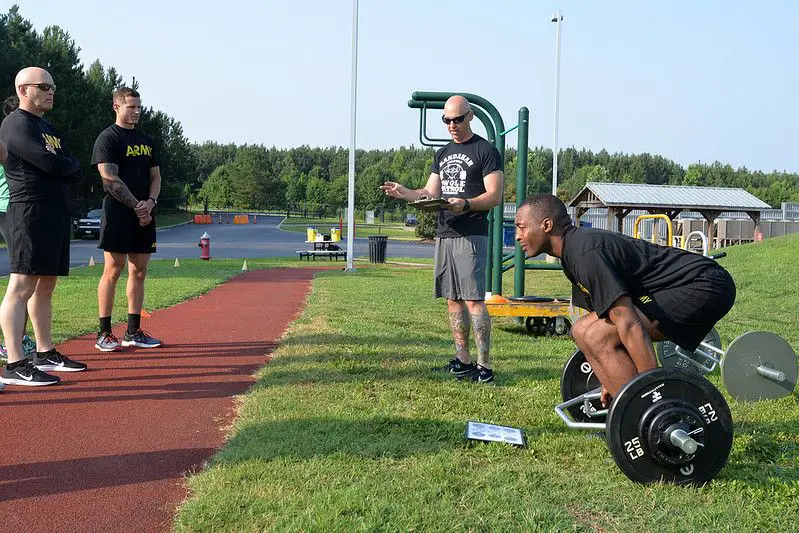
The best exercises for rucking target your legs (quadriceps, hamstrings, glutes, and calves), shoulders (deltoids), and abdominals. The 10 best exercises for rucking are:
- Walking lunge
- Jump Squats
- Weighted Squats
- Deadlifts
- Shoulder press
- Side laterals
- Plank
- Bicycle crunches
- Knee tuck crunch
- Back Extensions
Rucking is considered to be a compound movement. Meaning that it requires the activation and use of several muscles, simultaneously, to perform the activity. For example, when doing a bench press, you’re activating you pectoral muscles (chest), triceps, and front deltoid (shoulders). With that said, we need to make sure that all the muscles activated during a ruck are worked on as part of your workout plan.
What Muscles Does Rucking Work?
| Muscle Groups | Why is exercising this muscle important for rucking? |
| Legs (glutes, quads, hamstrings) | When rucking, you’ll be wearing the rucksack with the hip belt on to help distribute the weight evenly across your body. This is where your legs come to play, as they will help push the weight as well. |
| Shoulders | Strengthening your shoulders will help maintain proper posture. and help you endure the weight on your shoulders for much longer. |
| Abdominals | Strong abs are key to maintaining proper posture and preventing lower back pain. |
Learn more about why rucking is a good workout!
1- Walking Lunge

The walking lunge works mainly on your quads and glutes. Depending on your fitness level, you can do this with or without weights. Here’s how to do it:
- Stand with your feet shoulder apart
- Hold a dumbbell in each hand (optional)
- Take a diagonal step forward until your rear knee touches (or is just over the ground)
- Repeat with your other leg stepping forward.
2- Jump Squats
The jump squat is a compound movement that primarily targets your quads, hamstrings, and glutes. Here’s a step-by-step quick video on how to perform the jump squats correctly. One thing to note is that when your landing after the jump, be sure to land on the front of your feet as opposed to your heels.
3- Weighted Squats
Weighted squats are the pinnacle of leg workouts. They truly workout every muscle in your legs if done properly. Squats require proper form and mobility, doing them right is crucial to prevent injury. Here’s a quick guide by the Buff Dudes.
4 – Deadlifts

Deadlifts are a pillar exercise for strength training. It is works on your glutes. It made our list because it’s a compound movement that engages the quads and hamstrings. While deadlifts are great, they can really be painful if done incorrectly. Here’s a full step-by-step guide by Stronglifts.
5 – Shoulder press

The shoulder press will make it easier for your body to support the weight of the rucksack. Heres how to do it:
- Sit upright or stand with your feet shoulder width apart
- Hold the dumbell on each hand and carry both dumbbells so that your palms facing away from you
- Starting position: carrying the dumbbell so that your arm and forearm are at 90 degree angle
- Keep your chest up and abs engaged
- Press the weights straight up till your arms are extended fully, and repeat
6- Side Laterals
Side laterals are a good shoulder that works out your side lateral deltoid (the shoulder muscle has 3 main heads, anterior (front), posterior (rear), and side lateral). As previously mentioned, exercising your shoulders will help with your posture while rucking.
7- Plank
The plank is a great abs workout. According to Healthcorps, the plank strengthens your spine, your rhomboids and trapezius, and your abdominal muscles, which naturally results in strong posture as they grow in strength.
8- Bicycle Crunch
The bicycle crunch focuses on your abs, hips, and obliques.
9- Knee Tuck Crunch
The tuck crunch is when you do a crunch while your knees are bent in a 90-degree position. It mainly targets the abs. It’s a great workout since it’s accessible to people of any fitness level and is very effective.
10 – Back Extensions
The back extension primarily targets a number of muscles that are in your lower back. Lower back pain is a common problem among ruckers, where they feel that this area is most sore after a ruck. So might as well strengthen your lower back muscles!
